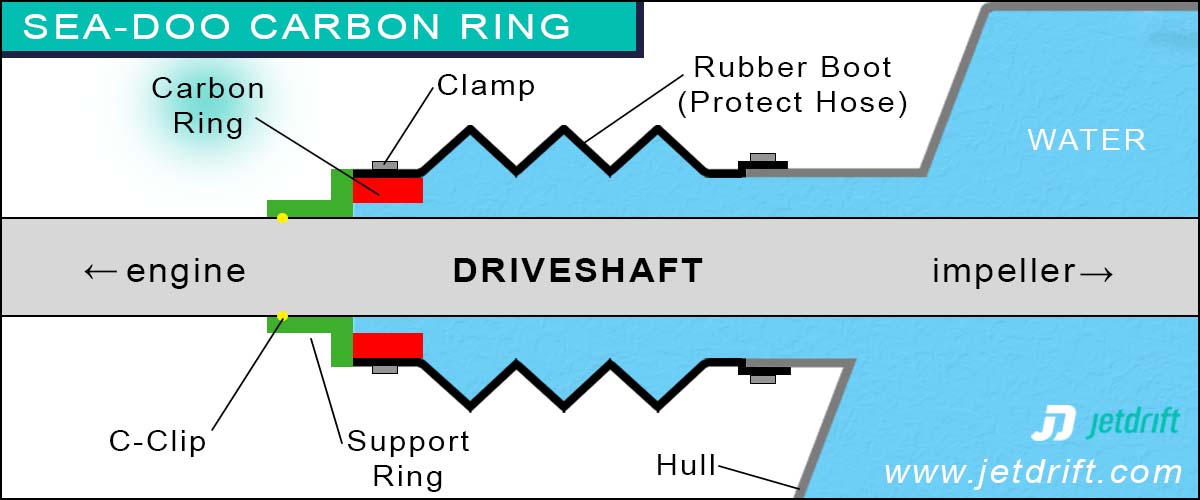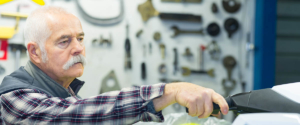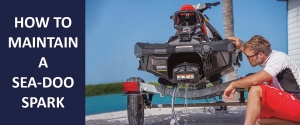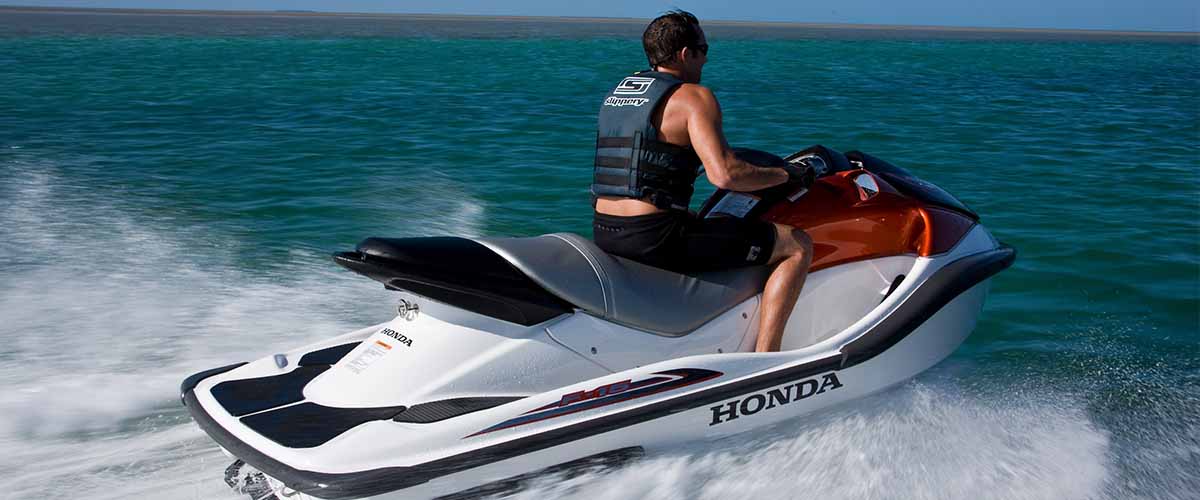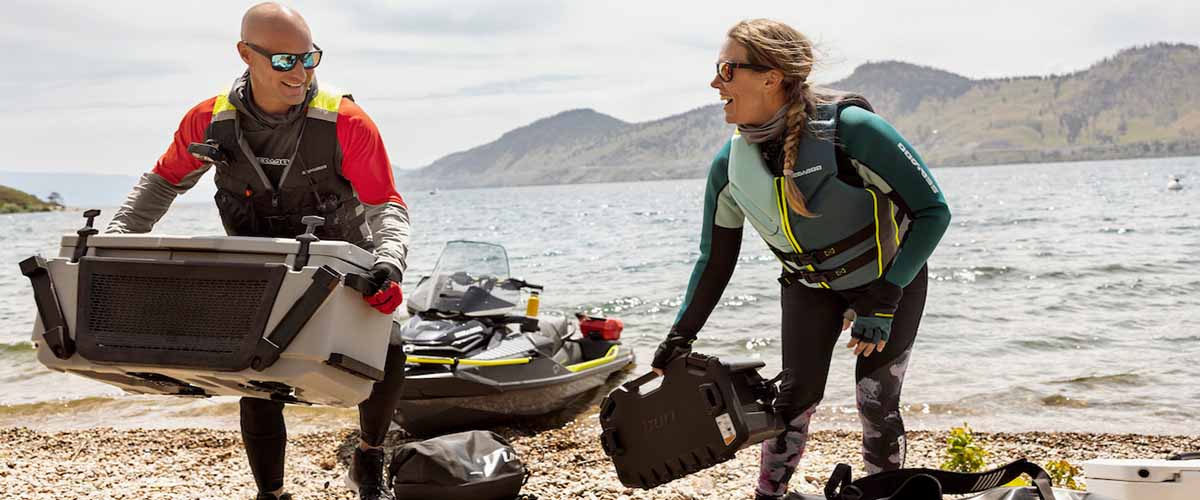How Does a Sea-Doo Carbon Ring Work? When Should it be Replaced?
A Sea-Doo carbon ring (known as a carbon seal as well) is a part of a seal that is designed to keep the water outside the hull. This small ring with the rubber boot and the metal support ring all encase the driveshaft to give it a waterproof seal.
As the carbon ring can wear out, it needs to be periodically replaced. Unfortunately, many owners overlook this maintenance task, which leads many Sea-Doos to sink!
That’s why every Sea-Doo owner must pay attention to periodic maintenance tasks!
If you are wondering how a Sea-Doo carbon ring works, this post is for you. Besides the basics, you can learn how to tell if the carbon ring is worn out, and how to replace it!
How Does a Sea-Doo Carbon Ring Work?
As the driveshaft has to go through the hull, there is a hole in it under the waterline.
Without proper sealing, water would flow into the hull along the shaft. This is where the carbon ring comes in handy. How does it work exactly?
A Sea-Doo carbon ring works in a very simple way. It wraps around the driveshaft and attaches to a rubber boot, while the other end of this boot is attached to the hull. There is another metal ring fixed on the driveshaft, known as the support ring or hat. The rubber boot works like a spring in this system, as it forces the carbon ring against the support ring, creating a watertight seal.
So finally, the carbon ring, the support ring, and the rubber boot together provide the seal for Sea-Doo’s driveshaft.
While these components keep the water out, they still allow the driveshaft to rotate with minimal friction. For a better understanding let’s check this video!
Are you wondering what happens if a carbon ring wears out? Keep reading!
What Causes Carbon Seal Damage?
Although there are many reasons why water may leak into a Sea-Doo from missed drain plugs to hull damage, one of the leading reasons is arguably worn carbon rings. If a carbon ring is damaged or just worn out a bit, water starts to leak directly into the hull. In the worst cases, the amount of incoming water can be so much that it can even sink the entire machine!
This typically happens if the craft is left in the water overnight or on longer tours when the hull is in the water for an extended period.
However, with proper maintenance and care most of these cases would be avoidable! Let’s see what the main causes of Sea-Doo carbon ring failures are, and how you can avoid them.
Why Do Sea-Doo Carbon Rings Go Wrong So Often?
In a nutshell, there are five typical causes of Sea-Doo carbon ring failures, which are as follows:
- Normal wear and tear
- Factory faults
- Overheating/lack of lubrication
- Aged drive shaft boot
- Engine misalignment/bent driveshaft
Let’s take a closer look at each!
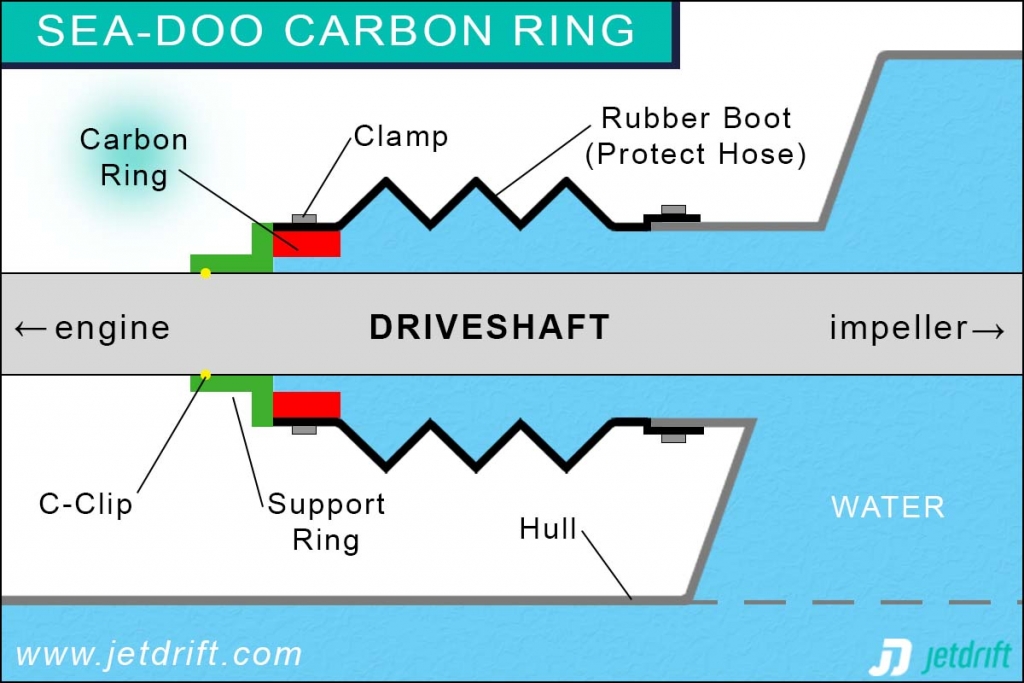
How does a Sea-Doo carbon ring work?
Normal Wear and Tear
It’s a lesser-known fact among Sea-Doo owners that the carbon ring seal is a wear item.
This means it needs regular inspection and periodic replacement. So yes, contrary to popular belief, Sea-Doo carbon rings don’t last forever.
If a carbon ring is correctly installed and serviced, you can expect many trouble-free hours on your Sea-Doo. Are you wondering what the replacement intervals of a carbon ring are? Since it may vary from one model to the next, always refer to your craft’s manual or ask your dealer.
As you can assume, the lifetime of a Sea-Doo carbon ring depends on several factors, like engine performance, type of the craft, your riding style, and many others.
You can expect the ring to wear out much faster on a 300 HP performance Sea-Doo than a tiny 60 HP Spark!
Moreover, according to the manufacturer, the ring and the rubber boot require more frequent inspections if you ride on dirty or foul water.
(We will discuss how to inspect a carbon ring in detail later in this post.)
Factory Fault
Let’s face it, carbon rings are manufactured not by Sea-Doo, but by outside suppliers. According to Watercraft Journal, on the pre-2020 models the material used by these suppliers was too weak. It seems this is one of the leading reasons why so many Sea-Doo carbon ring failures have occurred in previous years!
As we know the material the rings are made of is now more durable, which means these malfunctions are likely to occur much less frequently in the future.
However, it’s still recommended that you read your craft’s manual and pay attention to the service schedule. Additionally, you also have to operate the Sea-Doo correctly to avoid damaging the carbon ring!
Overheating and Lack of Lubrication
Sea-Doo’s carbon ring can be easily damaged by excessive heat and lack of lubrication. But where is this heat coming from?
The support ring on the driveshaft rotates very fast, while the rubber boot forces the carbon ring against it. As the carbon ring is stationary, this results in friction between the rings, which generates a lot of heat.
As long as the hull is in the water, these parts are always in contact with external water. This means the water not only lubricates the rings but also helps keep them cool.
But if you start the Sea-Doo out of the water, the rings are left without cooling and lubrication!
That’s why the manufacturer highly recommends not to operate a Sea-Doo longer than 90 seconds if it’s out of the water! Another key point is that the engine can be run only at idle speed.
Because of this, you have to be very careful when removing water from the water box. If you blip the throttle too hard, you can cause excessive wear on the carbon ring, or even damage it!
Unfortunately, this simple rule is often overlooked by many owners, which leads to many carbon ring failures.
Old Rubber Boot
Rubber parts are prone to aging, and the rubber boot around the carbon ring is not an exception. Due to aging, this boot (which is also known as protect hose or bellow) becomes shorter and weaker over time.
What’s more, it can also shrink from the aforementioned overheating issue as well.
A shortened boot can press the carbon ring with less force against the support ring. Finally, it can lead to a gap between these rings, which results in a water leak.
This is why the manufacturer recommends inspecting the rubber boot as well at every service interval.
Moreover, when you decide to replace a carbon ring, best practice is to replace the boot and the support ring as well.
Engine Misalignment / Bent Driveshaft
Surprisingly, in many cases carbon ring failures are caused by damaged or misalignment of other parts. The most common causes that lead to damaged carbon rings are as follows:
- Engine misalignment
- Bent/damaged driveshaft
- Broken or bent impeller
- Damaged/improper wear ring
All of these issues can cause vibration, which can damage the carbon ring in many ways. What’s more, a bent driveshaft or engine misalignment can also lead to uneven wear on the carbon ring.
Are you wondering where these failures come from?
For example, the driveshaft and impeller can easily be damaged if the pump sucks up a rope or a rock from the water.
Another issue could be if the shaft or even the engine was improperly installed in the factory or during maintenance.
But these are still not the leading reasons why so many Sea-Doos run with misaligned engines, but wave jumping is.
Wave jumping is very popular among reckless riders, but let’s face it, Sea-Doos are not designed for this!
The weight of a Sea-Doo engine can reach 200 pounds, which can generate large dynamic forces during every jump. These forces can lead to loosened or even broken engine mounts!
When the craft hits the water, there is always a risk that the engine will move out of its position, which ultimately results in permanent engine misalignment.
Another common issue is when the engine gets incorrectly reinstalled into the hull after servicing of tuning. Many tuners or repair persons think that aligning the bolt holes ensures the perfect engine position. But they are wrong!
It’s a lesser-known fact that professional Sea-Doo mechanics use a special alignment tool to make sure that the engine and the entire driveline is in the right position.
So, the scenario typically goes as follows:
Improper servicing/tuning/wave jumping with the Sea-Doo -> Engine misalignment -> Damaged carbon ring -> Water leaks into the hull
How Can You Tell if a Sea-Doo Carbon Seal is Bad?
To check the carbon ring on a Sea-Doo you have to remove the seat and take a closer look at the bilge. As a rule of thumb, Sea-Doo carbon seal symptoms are as follows:
- There is a lot of water in the bilge (especially around the rubber boot).
- Water is seeping between the two rings or around the boot.
- You can find carbon powder or pieces in the bilge.
- You can see signs of wear and tear on the carbon ring.
- Cavitation.
The most obvious sign of carbon seal damage is if you regularly find excessive water in the bilge. Even if water can seep into the hull from many other sources, it’s always a sign that you need to very thoroughly check the carbon ring.
It’s also good to know that a damaged carbon seal can cause cavitation as well. This is because not only water can seep into the hull, but air can also be sucked from the hull into the pump. If the carbon seal is bad, this means the pump can suck air from the engine compartment, which creates cavitation!
Experts say that the best way to inspect a Sea-Doo carbon ring is to remove it from the hull.
For this you will need to remove the support ring, rubber boot, and the whole driveshaft, so it’s wise to carefully inspect these parts as well.
But as these components are pretty cheap, it makes sense to replace them now that you‘ve removed the entire assembly.
Let’s see how to do it!
How to Replace a Carbon Ring on a Sea-Doo
You can easily replace the carbon ring on a Sea-Doo if you follow these simple steps:
- Remove the seat and the covers (if necessary).
- Drain the cooling system and engine oil (manufacturer’s suggestion).
- Remove the jet pump.
- Install a driveshaft supporter.
- Remove the intake hose of the supercharger.
- Slide back the support ring.
- Remove the C-clip.
- Remove the driveshaft.
- Remove the boot and the carbon ring.
- Install the new carbon ring into the new rubber boot.
- Reinstall the clamps.
- Reinstall the rubber boot with the carbon ring.
- Gently grease the driveshaft.
- Reinstall the driveshaft.
- Insert a new O-ring in a new support ring.
- Grease the O-ring.
- Slide the driveshaft into the engine.
- Reinstall the new support ring and C-clip.
- Reinstall the pump and the supercharger hose.
- Replace the covers.
Here is a great tutorial on how to replace a Sea-Doo carbon seal:
Besides these tutorials, always make sure to refer to your Sea-Doo’s service manual before you do any maintenance on it!
Sea-Doo Carbon Ring Kits
When it comes to replacing a Sea-Doo carbon seal, it’s always wise to replace the support ring, the C-clip, and the rubber boot as well. For your convenience, these parts usually come in a kit, known as “Sea-Doo carbon ring kit.”
To make this key unit more durable, you can even upgrade these parts with a heavy-duty carbon ring kit. These kits usually contain a thicker carbon ring and support ring.
The main advantage of these extended surfaces is that they offer a better seal compared to the original design.
How much does it cost to replace a Sea-Doo carbon ring?
Replacing a Sea-Doo carbon ring costs around $50-$100 depending on the model you own. For the newest and most durable kit be prepared to pay around $90-$100. But it’s worth every penny, as it’s like having more insurance on your Sea-Doo! And don’t forget, this is still just the cost of the parts. If you want to get the replacement done by a repair shop you have to count on paying the cost of labor as well.
Conclusion
It’s safe to say that the carbon seal is a critical part of every Sea-Doo, one that requires continuous attention and maintenance. Besides Sea-Doos, you can also find the same carbon ring design in Scarab and Chaparral boats as well.
As a takeaway, we’ve gathered the most frequently asked questions about this seal, with the shortest and best possible answers!
What is the carbon ring on a Sea-Doo? The carbon ring on a Sea-Doo is what helps seal the driveshaft.
What does the carbon ring do on a Sea-Doo? It keeps external water out of the hull.
How does a carbon ring work? A rubber boot forces the carbon ring against another metal ring, known as a support ring. Finally, these three components create the seal around the driveshaft.
How do you check a Sea-Doo carbon ring? Remove the seat and check the bilge around the driveshaft. For a more extensive inspection, you have to remove the rings and visually check them.
How can you tell if the Sea-Doo carbon seal is bad? Sea-Doo carbon ring symptoms are as follows: water in the bilge, carbon pieces/powder around the rings, cavitation in the pump, cracks and wear on the surface of the carbon ring.
How do you replace the carbon ring on a Sea-Doo? You have to remove the pump and the whole driveshaft to replace the carbon ring.
As a final word, don’t forget that the carbon ring on a Sea-Doo is cooled only when the craft is in the water. If you want to run the Sea-Doo out of the water, always follow the manufacturer’s recommendation, and run the engine at idle speed for a maximum of 90 seconds.
DISCOVER 2024 PWC MODELS Kawasaki, Sea-Doo, Yamaha, Krash…
